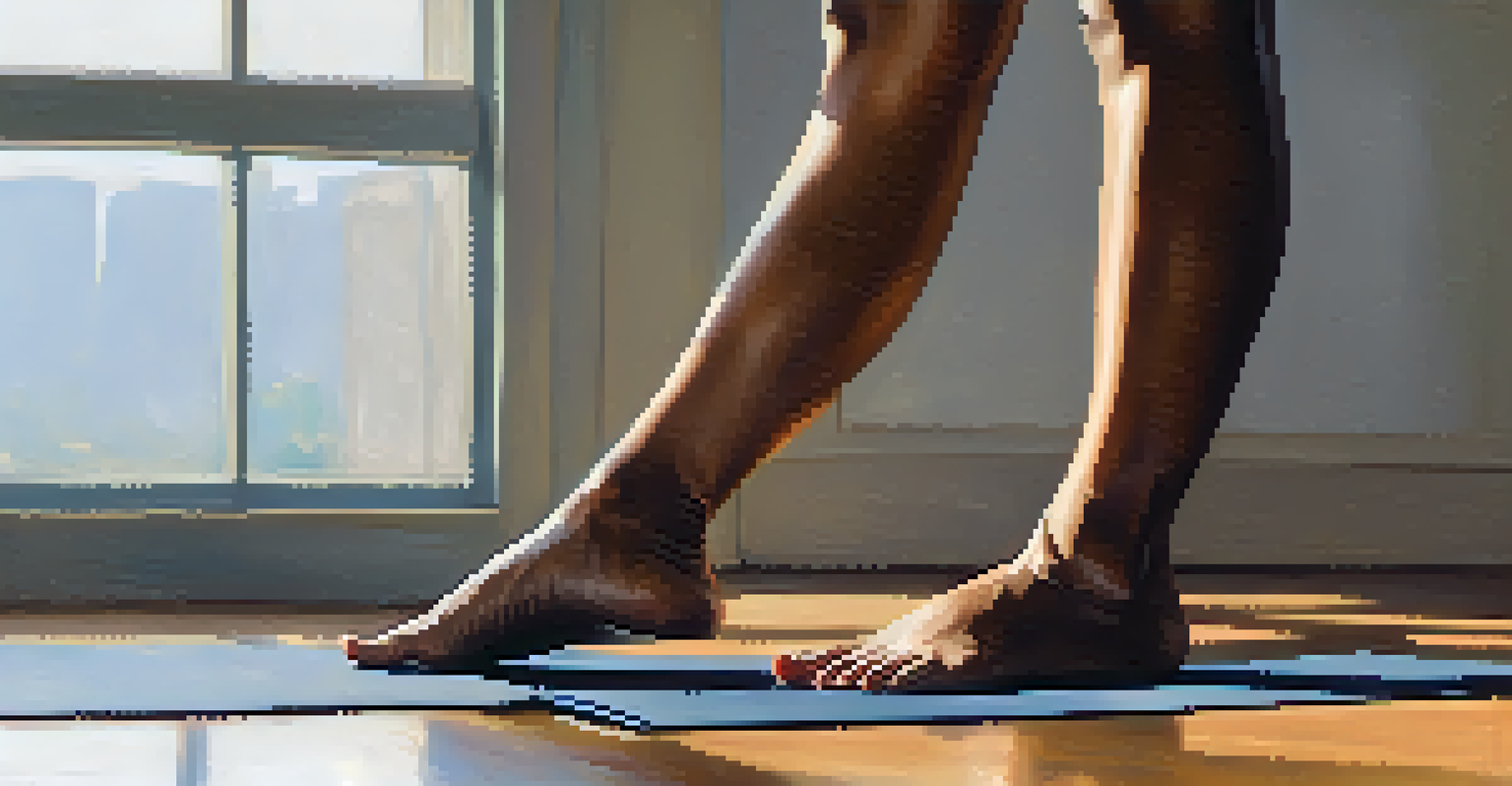Yoga Poses to Boost Strength and Endurance in Athletes

The Importance of Strength and Endurance for Athletes
Strength and endurance are crucial for athletes, impacting performance and injury prevention. Athletes need the power to excel and the stamina to sustain high levels of activity over time. Incorporating various training methods can help, but yoga uniquely targets both aspects through flexibility and balance.
Strength does not come from physical capacity. It comes from an indomitable will.
Yoga not only builds physical strength but also enhances mental resilience. This combination allows athletes to push through tough workouts and competitions. Understanding the synergy between physical and mental endurance can lead to improved overall performance.
Incorporating yoga into an athlete's routine can create a well-rounded foundation for success. It prepares the body for rigorous training and helps in recovery, making it an essential component of any athletic regimen.
Warrior I Pose: Building Core Stability and Leg Strength
Warrior I is a powerful pose that focuses on strengthening the legs and core while improving focus and stability. As you ground your feet and stretch your arms overhead, you engage multiple muscle groups, enhancing overall strength. This pose teaches athletes to maintain balance and poise, which are essential during intense training.

To perform Warrior I, start in a standing position, step one foot back, bend the front knee, and raise your arms. Ensure your hips face forward, creating a strong foundation. Holding this pose for several breaths will build endurance in your lower body and core.
Yoga Enhances Strength and Endurance
Incorporating yoga into an athlete's routine improves both physical strength and mental resilience, leading to better overall performance.
Athletes often find that Warrior I helps them establish a solid base for other athletic movements. It's a reminder that strength is not just about raw power; it's also about stability and control.
Warrior II Pose: Enhancing Endurance and Focus
Warrior II takes the foundation of Warrior I and builds upon it, further challenging balance and endurance. In this pose, you'll engage your legs deeply while keeping your torso upright, which helps develop stamina in your lower body. The extended arms also work on shoulder strength, crucial for many sports.
The difference between a successful person and others is not a lack of strength, not a lack of knowledge, but rather a lack in will.
To enter Warrior II, transition from Warrior I by opening your hips and shoulders to face the side while extending your arms parallel to the ground. This position encourages you to breathe deeply and maintain focus, essential skills for competitive athletes.
Athletes who practice Warrior II often report increased mental clarity and physical endurance. The pose embodies the idea that strength and focus go hand-in-hand, making it a favorite for those aiming to improve their game.
Chair Pose: Strengthening the Lower Body and Core
Chair Pose is an excellent way to build strength in the thighs, calves, and core while also enhancing endurance. When you sink into this pose, it mimics the action of sitting in an invisible chair, activating multiple muscle groups simultaneously. This intense engagement is perfect for athletes looking to boost their overall stability.
To perform Chair Pose, stand tall, bend your knees, and lower your hips as if sitting back in a chair while raising your arms overhead. Keep your weight in your heels and engage your core to maintain balance. Holding this position for several breaths builds muscular endurance.
Key Poses Build Core Stability
Poses like Warrior I and Plank focus on core stability, which is essential for maintaining balance and power in athletic activities.
Beyond physical strength, Chair Pose encourages mental toughness. Staying in the pose challenges your endurance, teaching you to withstand discomfort, a valuable lesson for any athlete in training.
Bridge Pose: Building Back and Hip Strength
Bridge Pose is an excellent way to strengthen the back, glutes, and hips, which are vital for athletic performance. By lifting your hips off the ground, you engage your back muscles while opening your chest and stretching your spine. This pose not only builds physical strength but also helps counteract the tightness that comes from many sports.
To do Bridge Pose, lie on your back with your knees bent and feet flat on the floor, hip-width apart. Press your feet into the ground as you lift your hips toward the sky, squeezing your glutes at the top. This pose can be held for several breaths to enhance endurance and strength.
Athletes benefit from Bridge Pose by improving their posture and alleviating tension in the back and hips. It's a gentle yet effective way to build strength in areas often neglected in traditional training.
Plank Pose: Core Strength and Stability
Plank Pose is a fundamental yoga position that significantly enhances core strength and stability. This pose requires you to hold your body in a straight line from head to heels, engaging your abdominals, back, and shoulders. As athletes know, a strong core is essential for power and balance in any sport.
To perform Plank Pose, start on all fours, then extend your legs back, lifting your body into a straight line. Keep your hands firmly planted on the ground, and focus on maintaining your form. Holding this position builds endurance and fortitude in your core.
Yoga Aids Recovery and Flexibility
Practicing poses such as Downward Dog helps athletes relieve tension and enhance flexibility, contributing to quicker recovery from rigorous training.
Incorporating Plank into your routine can lead to improved performance in various athletic activities. It teaches you to stabilize your body under pressure, a crucial skill when facing competition.
Downward Dog: Full-Body Strength and Flexibility
Downward Dog is a versatile yoga pose that strengthens the entire body while enhancing flexibility. This pose stretches the hamstrings, calves, and shoulders, making it fantastic for athletes who often deal with tightness from rigorous training. The strength built in Downward Dog translates to improved performance across various sports.
To enter Downward Dog, start on all fours, tuck your toes, and lift your hips toward the ceiling, creating an inverted 'V' shape. Keep your hands and feet grounded while allowing your heels to drop toward the floor. This position can be held to build endurance and flexibility.

Athletes often find that Downward Dog helps relieve tension and fatigue. It’s not only about building strength but also about enhancing recovery, making it a staple in many training routines.
Incorporating Yoga into Your Training Regimen
Integrating yoga into your training can yield significant benefits, enhancing both strength and endurance. The key is consistency; practicing these poses regularly will lead to noticeable improvements. Athletes can schedule yoga sessions on rest days or as a warm-up to complement their existing training.
It's essential to listen to your body during yoga practice. Focus on your breathing and engage in poses that feel right for you, gradually increasing intensity as you build strength and flexibility. This mindful approach ensures that you’re not only getting stronger but also developing a deeper connection with your body.
Ultimately, yoga offers a holistic approach to athletic training. By harmonizing physical strength with mental focus, athletes can elevate their performance and enjoy a more balanced, fulfilling training journey.